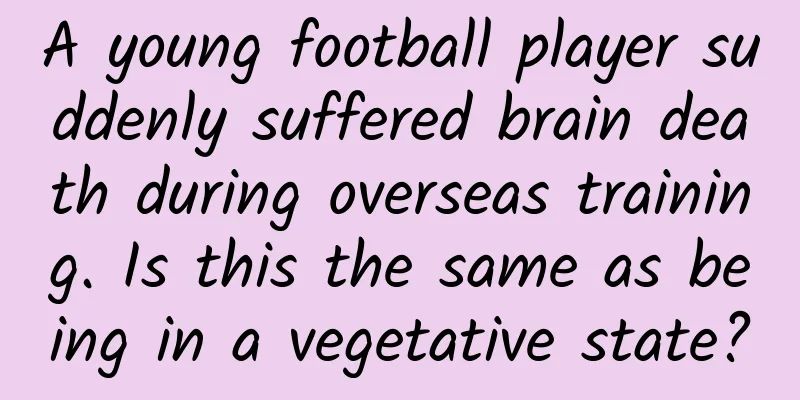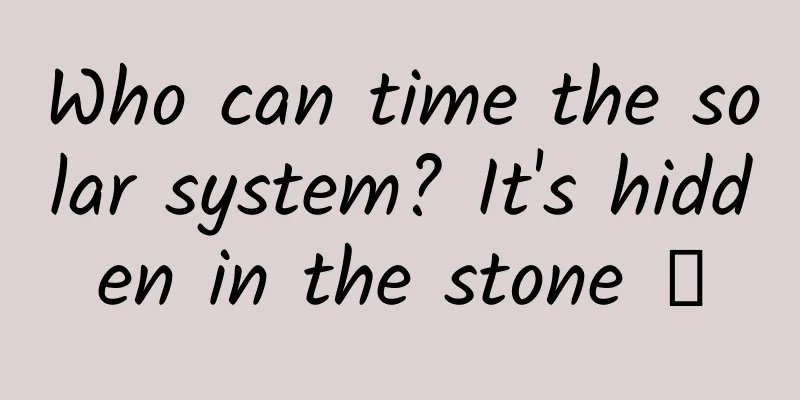A young football player suddenly suffered brain death during overseas training. Is this the same as being in a vegetative state?

|
Recently, there is a heart-wrenching news - 18-year-old Beijing Guoan football player Guo Jiaxuan suffered a head injury and brain death during a training camp in Spain. It is also reported that Beijing Football Association staff confirmed that the player Guo Jiaxuan suffered a serious brain death during the training camp, which was an accident caused by normal defense and tackling. On February 14, with the efforts of many parties, Guo Jiaxuan returned to China via a chartered flight of an international rescue organization and was admitted to Beijing Tiantan Hospital for emergency treatment. Both the Beijing Football Association and Beijing Guoan Football Club said, "As long as there is a glimmer of hope, we will not give up." On February 19, Guo Jiaxuan's family revealed that Guo Jiaxuan's condition has not improved, "We have gradually accepted the reality." Now all the doctors can do is to maintain Guo Jiaxuan's basic body functions. He revealed that after Guo Jiaxuan was transferred to Tiantan Hospital, experts also conducted another consultation, and the result was still brain death, "there is no treatment." A local doctor in Spain said that Guo Jiaxuan was already brain dead when she was sent to the hospital, "probably because of brain hypoxia caused by respiratory arrest," so the first aid process before being sent to the hospital is very important. Is there any hope of resurrection after being declared brain dead? Many countries and regions have passed legislation to make brain death one of the criteria for determining death. When it comes to medical activities such as organ donation, the determination of brain death is of great significance. For example, Finland is the first country in the world to define brain death as human death in the form of national law. In 1978, the United States enacted the Uniform Brain Death Act. In 1997, Germany's organ transplant law stipulated that brain stem death is human death. In my country, the criteria for identifying brain death are extremely strict. It requires three conditions: deep coma, loss of brainstem reflexes, and no spontaneous breathing. It can only be confirmed after close observation and repeated examinations over a certain period of time. Once brain death is confirmed, it is equivalent to declaring clinical death, and no clinical measures can reverse it. Doctors who determine brain death must be practicing doctors who have been engaged in clinical work for more than 5 years, limited to neurology, neurosurgery, critical care medicine, emergency department, anesthesiology, pediatrics (for children aged 29 days to 18 years old), and must undergo standardized brain death determination training and obtain the corresponding qualifications before they can make a determination. At the same time, at least 2 clinical doctors and at least 1 neurologist are required to make the determination at the same time, and the diagnosis can only be confirmed if they agree. Clinical death refers to the cessation of heartbeat and breathing, the medulla oblongata is in a state of deep depression and loss of function, but the functional activities of the brain centers have not yet entered an irreversible state. The criteria for determining clinical death are relatively simple, and the cessation of heartbeat and breathing can be initially determined, but in some emergency situations, it may be reversed through means such as cardiopulmonary resuscitation. In areas where there is no clear legislation on brain death, it is still the main basis for determining death, declaring the end of an individual's life activities from a legal perspective. Brain death is the irreversible loss of all brain functions, including the brainstem. Although machines and drugs can maintain the patient's breathing, heartbeat, blood pressure and other physiological functions for a period of time when the patient is brain dead, no matter what medical means are taken at this time, the patient's life cannot be saved. Once these auxiliary facilities are removed, the heartbeat will soon stop. Compared with clinical death, determining death based on brain death is more scientific, reliable and standardized. What causes brain death? The brain and brainstem are the "supreme commanders" of the human body that receive signals and send out commands. Once the brain and brainstem lose their functions, other organs of the body will no longer be able to work together, nor will they be able to respond to environmental changes, and eventually clinical death will occur with respiratory and heart arrest and disappearance of various brainstem reflexes. This is brain death - the irreversible loss of all brain functions, including the brainstem. The causes of brain death are divided into primary brain injury and secondary brain injury. Primary brain injury is a disease that originates in the brain, such as head trauma caused by falling from a height or a car accident, large-area cerebral infarction or massive cerebral hemorrhage caused by blockage or rupture of large blood vessels in the brain, etc. Secondary brain injury refers to insufficient blood and oxygen supply to the brain due to damage to other important organs of the body, such as cardiac arrest, severe suffocation, drowning, etc., which ultimately leads to hypoxia and necrosis of brain tissue. Generally speaking, if the blood flow to the cerebral arteries is interrupted for more than 4 to 6 minutes, the nerve cells will be irreversibly damaged, and the final result of irreversible damage to all brain cells is brain death. Brain death ≠ vegetative state! For the general public, "vegetative state" and "brain death" are indeed a pair of concepts that are easily confused. "Vegetative state" refers to the complete lack of awareness of the patient and the surrounding environment, but they are still partially awake. Vegetative state also has primitive reflexes such as sucking, chewing and swallowing, as well as basic reflexes such as spontaneous or reflex eye opening and reflexive avoidance of pain. Although vegetative patients are also in a coma, their brains have not completely stopped working, and they may still retain some brain stem functions, such as autonomous breathing, sleep-wake cycles, etc. "Vegetative patients" are in a coma due to severe damage to the cerebral cortex or a state of sudden inhibition. Their brain stem functions are normal, and they have autonomous breathing, heartbeat, blood pressure, etc. Some patients can even open their eyes and smile. With careful care, they can survive for a long time, and even if they lie in bed for several years or even more than ten years, there is still a possibility of waking up. Brain-dead patients are in an irreversible coma and will never wake up again. How to avoid primary brain damage? Primary brain injury is one of the key factors leading to brain death. Primary brain injury may occur when the head suffers violent impact, penetrating injury, or severe trauma caused by falls, traffic accidents, etc. The prevention of primary brain injury requires us to start from all aspects of daily life, improve safety awareness, abide by safety rules, and strengthen self-protection. 1. Obey traffic rules: Traffic accidents are one of the main causes of primary brain injury. Therefore, we must strictly abide by traffic rules. At the same time, pedestrians should also pay attention to traffic safety, use zebra crossings when crossing the road, and do not cross the road at will. 2. Wear a helmet during high-risk activities: Wear a helmet when engaging in high-risk activities, such as riding a bicycle, motorcycle, skateboard, etc. A helmet can effectively protect the head from impact and reduce the risk of primary brain injury. 3. Pay attention to home safety: There are many hidden dangers in the home environment that may cause primary brain damage. For example, the furniture should be placed firmly to prevent objects from falling and injuring people; the ground should be kept dry to avoid slipping; the wires should be laid in a standardized manner to avoid tripping, etc. 4. Pay attention to safety when participating in sports activities: When participating in sports activities, choose appropriate sports and avoid high-risk sports. At the same time, follow the rules of the sport and wear protective gear to avoid accidental injuries during exercise. 5. Child safety protection: For children, parents should strengthen their care to prevent them from coming into contact with dangerous items. At the same time, they should educate children on correct safety knowledge, let them know which behaviors are dangerous and how to avoid accidental injuries. 6. Improve self-protection awareness: In daily life, we must always be vigilant and improve our self-protection awareness. When encountering dangerous situations, we must take quick measures to avoid head injuries. 7. Learn first aid knowledge: Mastering basic first aid knowledge can help you save yourself or others in time when an accident occurs. For example, learn how to deal with emergency situations of craniocerebral injury, such as stopping bleeding and fixing wounds. In addition, we should also pay attention to the early identification and treatment of craniocerebral injury. Once a craniocerebral injury occurs, seek medical attention in time. Source: Department of Neurosurgery, Peking University International Hospital, Science Popularization China, Chang'an Street Governor, Oriental Sports Daily, China Youth Daily |
<<: What happens when a black hole passes close to the Earth?
Recommend
Growth Hacker: Amap’s Path to User Growth!
On October 1, Liu Zhenfei, Alibaba partner and pr...
13 aspects to consider when developing a mobile app
This article is for newcomers to the field of mob...
Is it reliable to find a partner through body odor?
Our body odor stores a wealth of biological infor...
What’s the use of liking Tik Tok? What are the disadvantages of buying likes on Douyin?
There are many indicators for judging the popular...
What is eBook marketing? How to market and promote e-books?
There are many means of online promotion . We sho...
What does the easternmost part of China look like?
2008 Heixiazi Island, which has been drifting for...
How did the beautiful and refreshing "Paris Green" become the "deadly fashion color" of the Victorian era?
1862 was a desperate year for Richard and his wif...
3 ways to break down your user growth strategy
When making your growth strategy for the new year...
Tieling SEO Training: Is it difficult to optimize the keywords on the homepage of the website? How to achieve this goal?
Improving keyword rankings is a very critical ste...
Will eating these things often really make you ugly? Beware of these 8 types of food
Someone once complained online: "Why do I fi...
The establishment of the fourth operator of the State Grid may promote the development of 4K TV
In recent years, there have been more news report...
Public account fission: 0 budget, 3 times the number of fans in 3 days
A good fission method can be reused. The number o...
20 common usage examples of time and date libraries in Java 8
[[177393]] In addition to lambda expressions, str...
After taking over the box market, Alibaba Digital Entertainment upgraded its living room strategy and aimed directly at smart TVs
In recent years, the combination of "Interne...









